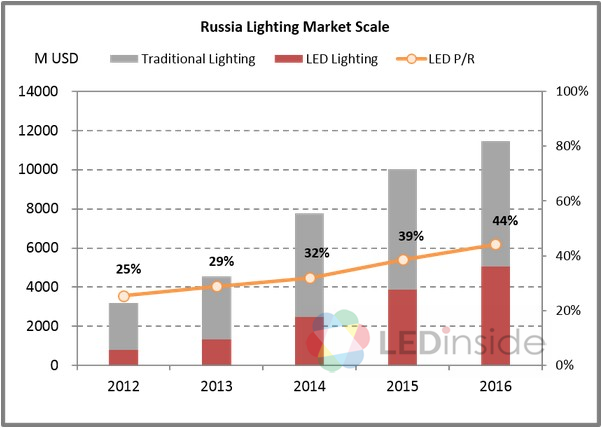In recent years, the LED lighting market has blossomed in emerging countries, and manufacturers’ development strategies in these markets have become increasingly important. This is mainly because in mature markets, such as Europe and Japan, global traditional luminaire brands still have the greatest market share. While in highly competitive countries, such as China where it appears profitable, many manufacturers have been unable to reap profits.
 |
|
(Source: LEDinside) |
Russia spans 17 million square meters, and is one of the largest countries in the world, with a population of 143 million the country is globally ranked in ninth by population. The country’s GDP also places in eighth place globally. This apparently large lighting market is estimated to have a total market value of $ 7.8 billion in 2014, said Roger Chu, Research Director, LEDinside. The country’s LED product applications are similar to advanced countries, and has a high 32% market penetration, which is expected to further grow to 44% by 2016. Despite the overall growth rate in the lighting market, and LED products penetration rates, the Russian niche market has the highest market potential.
Additionally, the Russian market is very different from other emerging markets. In terms of market distribution, the Russian market has showed better performance. Based on LEDinside’s actual visits and verification, up to 60% of the Russian outdoor luminaire market is in the control of specified manufacturers. This sets Russia apart from other emerging markets, such as Southeast Asia where big international brands including Philips and Pannasonic have the most market share, while local brands only have 30% market share in specific lighting application markets. The Russian markets special features has urged analysts to use more flexible models that include more variables when analyzing local market trends to acquire highly objective and reliable market information.
Based on LEDinside analysts observations, there are three key factors in the LED lighting markets:
1. LED industry is highly reliant on imports
Up to 99% of the country’s LED supply chain relies on imports, whether it is LED package, power drivers and even thermal dissipation modules. Even over 50% of the country’s luminaires are imported. With such a huge market demand, the lack of a comprehensive supply chain, manufacturers in the Greater China region or European and U.S. manufacturers with the technology know-how should take the opportunity to enter the market, develop businesses and obtain import partnership relations.
2. Russian economic trends
When news reports noted the Japanese Yen depreciated more than 17%, the value of the Russian Ruble had plummeted more than 55%. Sanctions imposed by U.S. and Europe in response to Russia’s decision to send troops to Ukraine and plunging global oil prices, were the main reasons behind the Ruble’s depreciation. For a country highly reliant on imports, this will also lead to rising import costs, leading to Russia’s high luminaire costs. Due to these reasons, LEDinside analysts believe Russian manufacturers aim to assist local suppliers, which presents a good opportunity for foreign manufacturers with the technology know-how to form strategic alliances with Russian manufacturers.
3. Business developments highly dependent on “partnerships”
In the face of proud and resilient Russians, standard business models such as “finding clients,””testing product samples” and “early introduction”, will not work. Russians do not care about your company’s products, they value “partnership relations” even more. How well acquainted are you with government agencies? Financial institutes? Is your company related to Sovereign Wealth Funds? All these are the keys to attracting Russian companies to do business with you. Furthermore, once Russians recognize you as a business partner they will not easily severe ties, but tend to develop long lasting partnerships.












